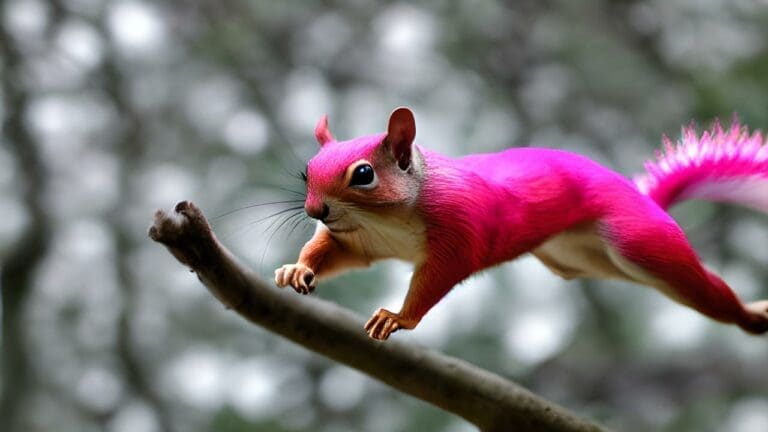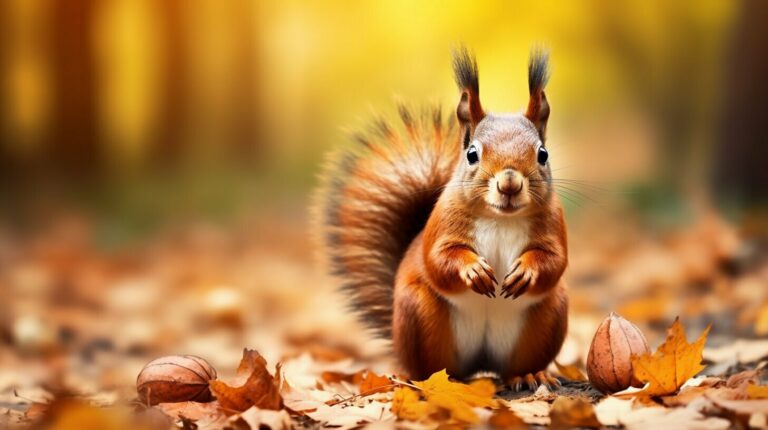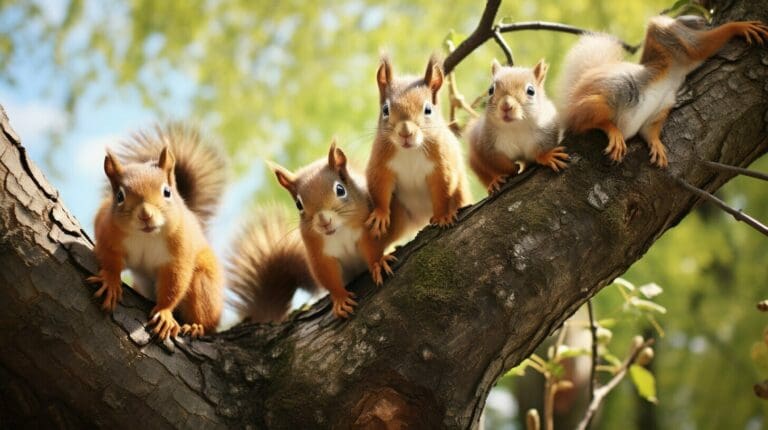What is the Most Interesting About Squirrel? Unveiling Secrets
Move over, cats and dogs; it’s time for squirrels to take center stage. These furry critters are more than just a common backyard sight; they’re fascinating creatures with a wealth of secrets to unravel. From their natural habitat and diet to their unique adaptations, squirrels have captured the hearts of many wildlife enthusiasts.
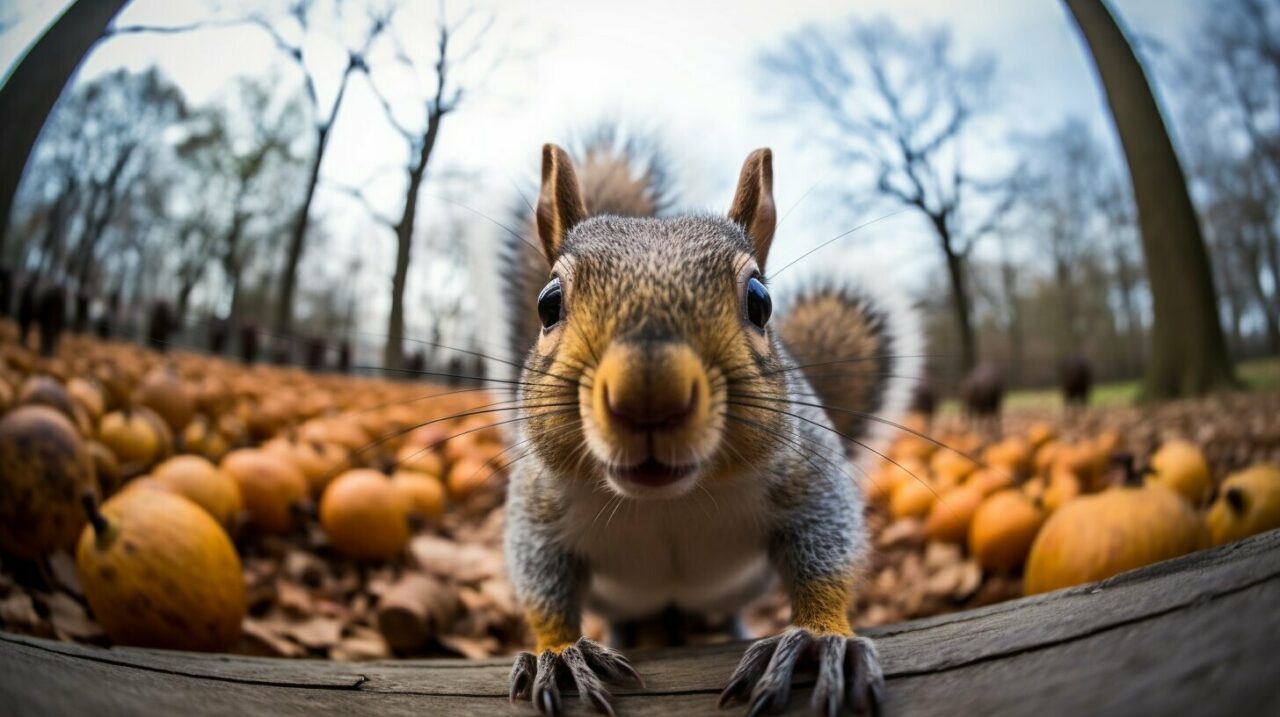
But what is it that makes squirrels so interesting? Is it their acrobatic feats? Their cheeky behavior? Or perhaps their impressive problem-solving skills? In this section, we’ll dive into the captivating world of squirrels and explore what makes them one of the most intriguing creatures in the animal kingdom.
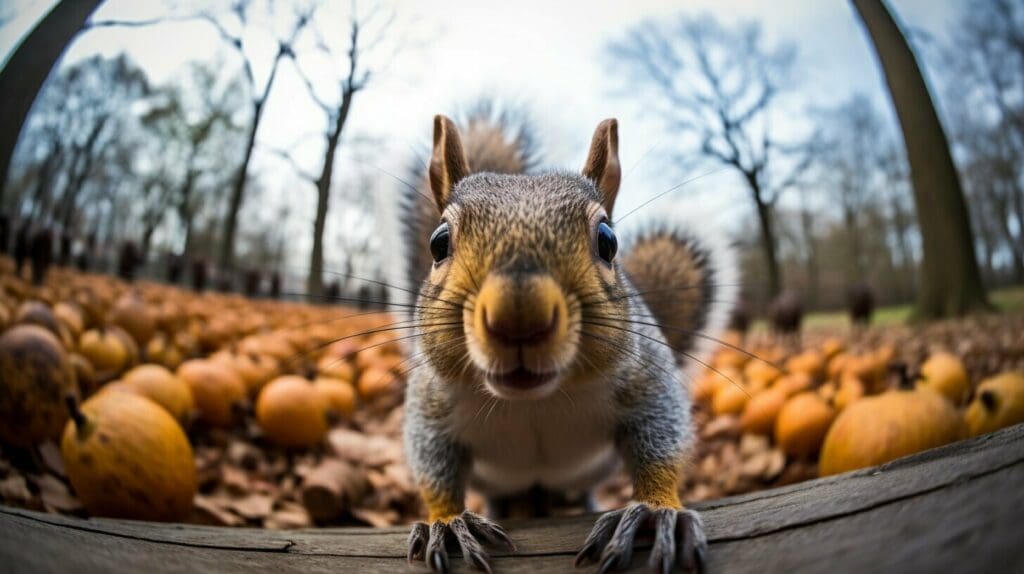
Key Takeaways:
- Squirrels have many interesting qualities and behaviors that make them captivating creatures.
- From their natural habitat and diet to their unique adaptations, there are many secrets to uncover about squirrels.
Squirrel Behavior: Surprising and Intriguing
Regarding animal behavior, squirrels are in a league of their own. These furry creatures display a wide range of behaviors that are both surprising and intriguing to observe. From their playful antics to their obsessive nut-burying, squirrels never cease to amaze.
Squirrels’ Athleticism: Beyond Human Capabilities
One of the most fascinating aspects of squirrel behavior is their incredible athleticism. These creatures can easily leap up to 10 times their body length and easily navigate trees, making them seem almost superhuman. And while their acrobatic abilities are impressive, their flexibility truly sets them apart. Squirrels can twist their bodies in amazing ways, allowing them to move through narrow spaces and contort themselves into strange positions.
But why are squirrels so athletic? Well, it’s all about survival. Squirrels must be quick and agile to escape predators and navigate their environment. By developing these skills, they can live longer and increase their chances of passing on their genes.
The Nut-Burying Obsession: A Survival Tactic
Anyone who has spent time observing squirrels knows they have a bit of an obsession with burying nuts. But why do they do it? It turns out that this behavior is a survival tactic. Squirrels bury nuts to store for the winter when food is scarce. They can remember where they buried each nut, using landmarks and their sense of smell to locate the buried treasure when they need it most.
In fact, squirrels take nut burying so seriously that they will go to great lengths to protect their stash. They have deceived potential thieves by burying empty shells or digging fake holes to throw off their competitors.

Tree Squirrels vs. Ground Squirrels: Different Behaviors for Different Environments
While all squirrels share many of the same behaviors, some differences depend on their environment. Tree squirrels, for example, are more solitary and territorial than ground squirrels. They will defend their territory fiercely, using vocalizations and physical displays to warn off competitors. Ground squirrels, on the other hand, are more social and live in large colonies. They work together to protect their burrows and share resources, creating a tight-knit community.
No matter where they live, squirrels are sure to entertain with their fascinating and sometimes quirky behaviors. From their acrobatics to their nut-burying obsession, these creatures are truly one-of-a-kind.

Squirrel Adaptations: Masterful Survival Skills
When it comes to survival, squirrels are the masters of adaptation. These resourceful creatures have evolved a variety of tactics to thrive in different environments and overcome challenges in their daily lives. Let’s take a closer look at some of these clever adaptations.
Sharp Claws and Teeth
Squirrels have razor-sharp claws and teeth that enable them to climb trees effortlessly and crack open tough nuts. Their front teeth never stop growing, so they must constantly gnaw on hard objects to keep them from overgrowing.
Fun Fact: A squirrel’s front teeth can grow up to six inches per year!
These teeth are incredibly strong and can exert a pressure of up to 22,000 pounds per square inch, making them powerful enough to gnaw through wood, plastic, and electrical wires.
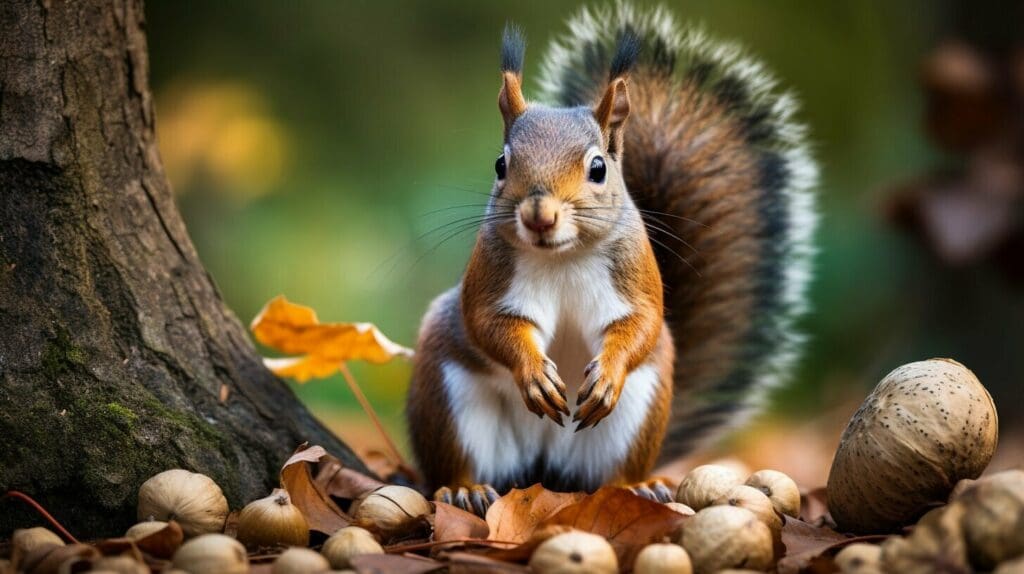
Agile Bodies
Squirrels are also renowned for their agility. They have flexible bodies that can contort into different shapes, allowing them to squeeze through tight spaces and acrobatically jump from branch to branch.
Furthermore, they have a unique adaptation known as “patagia,” or flaps of skin, that stretch between their front and hind legs, allowing them to glide through the air from one tree to another.
- These gliding abilities help squirrels escape predators, find food, and travel long distances with little effort, making them incredibly efficient.
- While in the air, squirrels can adjust their trajectory and brake by using their tail as a rudder, allowing them to land safely and accurately.
Food Storage
Squirrels are also famous for their food-hoarding behavior, where they stockpile nuts and seeds to eat later in the year when food is scarce. To do this, they have developed an impressive memory and a keen sense of smell.
When squirrels find a food source, they will repeatedly visit it, memorizing its location and scent, then gathering as much food as possible. They then bury the food in caches that they can easily locate later on.
This behavior is crucial for their survival in the winter, where food is scarce, and their cache of stored food can mean the difference between life and death.
Camouflage
Squirrels have another intelligent adaptation to protect themselves from predators: camouflage. Some species of squirrels have coats that change color depending on the season, allowing them to blend in with their surroundings.
For example, the Arctic ground squirrels have a white coat in the winter to blend in with the snow, but their coat turns brown in the summer to match the ground.
Other species have a distinctive pattern or coloration that helps them blend in with the trees and foliage, making them difficult for predators to spot.
These adaptations are just some of the many ways that squirrels have evolved to survive in their natural habitat. Their resourcefulness and adaptability make them fascinating creatures to observe and study.
Squirrel Diet: Nutritious and Diverse
Have you ever wondered what squirrels eat? These fluffy-tailed creatures have a diverse and nutritious diet that helps sustain their energetic lifestyle. Let’s explore the different types of foods that squirrels love to munch on.
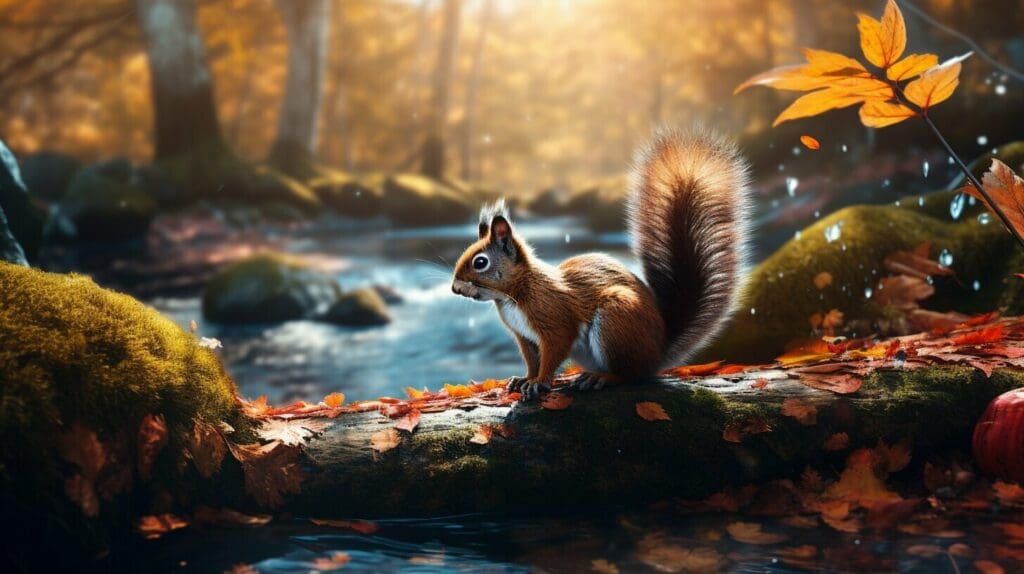
Squirrels are primarily herbivores, meaning that they feed mostly on plants. They have a particular love for nuts and seeds, which make up a significant portion of their diet. Squirrels have strong jaws and teeth, allowing them to crack open even the toughest nut shells, such as acorns and walnuts.
But squirrels aren’t picky eaters–they also enjoy various fruits, berries, and even insects. They are known to feast on apples, berries, and mushrooms when they are available, and they also eat insects such as grasshoppers and caterpillars.
Interestingly, squirrels have also been observed eating bird eggs and nestlings. While not a common occurrence, it’s a reminder that squirrels are opportunistic eaters and will take advantage of any available food source.
Their diverse diet helps squirrels stay healthy and energetic, allowing them to perform cute and acrobatic antics, like leaping from tree to tree and easily running up and down branches. So, next time you see a squirrel munching on something, take a closer look–you might be surprised by what you find!
Squirrel Habitat: Exploring Nature’s Playground
When you think of squirrels, you might envision them scampering up trees in a forest setting. While it’s true that squirrels are often found in woodlands and forests, they are also highly adaptable to various habitats, including urban environments. In fact, many city-dwellers are familiar with the sight of squirrels darting across power lines or scurrying up lamp posts.
One of the reasons squirrels are so successful in different habitats is their ability to adapt their behavior and diet to suit their surroundings. For example, squirrels living in heavily wooded areas may rely more heavily on nuts and seeds, while those in urban areas may supplement their diet with discarded food scraps.
Another interesting aspect of squirrel habitat is its role in their social behavior. Squirrels are known to have communal nests, called dreys, that they use for sleeping, shelter, and raising young. These dreys can be found in trees but also in attics, chimneys, and other man-made structures.

It’s important to note that while squirrels may seem cute and harmless, they can sometimes cause damage to property and even pose a threat to human health. For this reason, it’s best to enjoy squirrels from a safe distance and avoid feeding them.
Despite any potential drawbacks, squirrel habitat remains a fascinating subject for nature lovers and casual observers alike. From their acrobatic maneuvers in the treetops to their resourceful adaptations in our cities, squirrels are a testament to the incredible diversity and resilience of the animal kingdom.
Squirrel Intelligence: Cleverness in Action
For many people, squirrels are seen as cute but ultimately simple creatures. However, those who take a closer look at these little mammals will likely be astounded by their intelligence and resourcefulness. Squirrels have displayed impressive problem-solving abilities, adaptability, and even socially intelligent behaviors that have piqued the interest of researchers.
One example of squirrel ingenuity is their ability to outsmart bird feeders. Anyone who has tried to keep squirrels out of their bird feeders knows how relentless these little creatures can be. However, squirrels have demonstrated a remarkable ability to solve problems and overcome obstacles to get to the food they crave. Some squirrels even memorize complicated sequences of movements needed to access their desired food source.

This problem-solving ability is not only limited to food sources, as squirrels have also been shown to navigate complex obstacles in order to reach their destination. In a study, a squirrel was presented with a maze that required it to complete a series of complex steps to obtain a reward. Not only did the squirrel solve the maze, but it could also remember the sequence of movements needed to solve it when presented with it again a month later.
But not just their smarts fascinate squirrels; they also have socially intelligent behaviors. For example, squirrels have been observed using tail flicking to communicate with others of their species. Based on scent cues, they can also discern whether a nearby squirrel is a relative or a stranger and adjust their behaviors accordingly.
Overall, squirrels are far from simple-minded creatures, as they exhibit impressive intelligence in various situations. From clever problem-solving skills to socially intelligent behaviors, these little mammals have certainly shown that they cannot be underestimated.
Squirrel Communication: Unspoken Signals
Although squirrels don’t have a complex language like humans, they have their unique ways of communicating with each other. These unspoken signals are just as effective in conveying information and establishing social hierarchies.
For example, when a squirrel flicks its tail rapidly, it’s a sign of agitation or warning to nearby squirrels. On the other hand, slow tail flicking can indicate a relaxed and content state. Squirrels also use vocalizations, such as chirping and chattering, to communicate with each other.
Body postures, like arching the back or standing on hind legs, can convey dominance or submission in social interactions. Squirrels may also use scent marking to communicate and claim territory.
These unspoken signals allow squirrels to navigate their complex social lives without the need for a vocal language. It’s a fascinating example of how animals adapt and communicate in their natural habitats.

As the saying goes, actions speak louder than words – even for squirrels.
Conclusion: The Enigmatic World of Squirrels
From impressive acrobatics to resourceful problem-solving skills, squirrels are undoubtedly some of nature’s most fascinating creatures. By delving into their behavior, adaptations, diet, and habitats, we’ve uncovered some of the secrets that make squirrels so unique and captivating.
Whether you’re watching them dart through your backyard or observing them in their natural habitats, squirrels are always ready to provide a bit of entertainment and intrigue. And with their unspoken language, it’s clear that they have a lot to communicate even if we don’t always understand it.
In Conclusion
So the next time you spot a squirrel in your backyard or on a nature hike, take a moment to appreciate the wonder of these enigmatic creatures. From their intelligence to their survival skills, squirrels are truly a marvel of the animal kingdom.
By learning more about squirrels, we gain a deeper appreciation for the natural world and its creatures. So go ahead, grab a handful of nuts, and settle in for some squirrel watching. You might just be surprised by what you discover.
FAQ
Q: What is the most interesting thing about squirrels?
A: Squirrels have many secrets to reveal, from their behavior and adaptations to their diet and habitat. Let’s unveil the fascinating world of squirrels!
Q: What are some surprising squirrel behaviors?
A: Squirrels are known for their acrobatic leaps and their habit of burying nuts. Discover the intriguing reasons behind these behaviors and more in this section.
Q: How have squirrels adapted to survive?
A: Squirrels have developed remarkable adaptations, such as sharp claws and the ability to store food, that contribute to their survival. Explore their masterful survival skills here.
Q: What do squirrels eat?
A: Squirrels have a diverse diet that includes nuts, seeds, fruits, berries, and even insects. Find out more about their nutritious and varied food choices.
Q: Where do squirrels live?
A: Squirrels can be found in various habitats, from forests and woodlands to urban parks and gardens. Discover the different environments where squirrels reside.
Q: How intelligent are squirrels?
A: Squirrels display impressive problem-solving abilities and resourcefulness. Learn about their cleverness in action and their ability to navigate complex situations.
Q: How do squirrels communicate?
A: Squirrels communicate through tail flicking, vocalizations, and body postures. Uncover the hidden language of these creatures and their unique methods of communication.
Q: What have we learned about squirrels?
A: By exploring the secrets behind squirrels’ behaviors, adaptations, and intelligence, we have gained a deeper appreciation for these enigmatic creatures. Enhance your knowledge of nature and the wonders of the animal kingdom in your own backyard.
